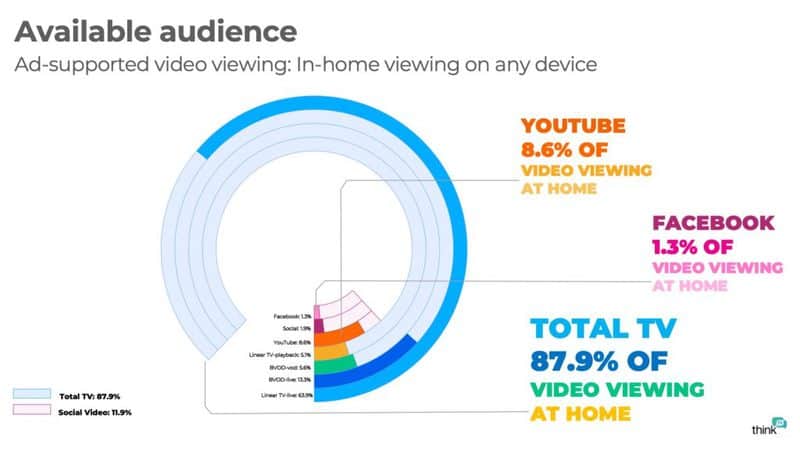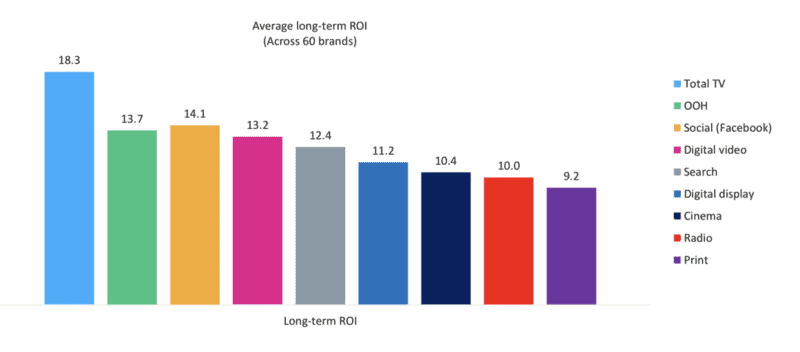The past year served up more learnings about video advertising than there were meltdowns on Married at First Sight. And if the relentless Blursdays of 2021 messed up your memory banks, we’ve got you covered.
ThinkTV has taken a look back across last year and penned a handy summary of the top 21 things you should know about video advertising in 2021.
1. TV remains the king of at-home viewing
There’s a sea of choice for viewers hungry for video; from BVOD to Binge, TikTok to Stan and everything in between. But when it comes to video advertising, it’s a much more straightforward decision. It seems so obvious to say it but here goes: brands can only advertise on video platforms supported by advertising.
To understand viewing patterns across ad-supported platforms, ThinkTV got OzTAM to blend data from the TV audience measurement panel, along with the national streaming meter panel. And, for the first time ever, we created a snapshot of ad-supported video viewing, in-home and on any device.

And what it found is that Total TV commands a thumping great big 87.9% of at-home viewing.
2. TV is great in the long term…
Sometimes you run a campaign because you need the impact right away, other times you’re in it for the long haul. Lucky Total TV has you covered for both. In 2021, ThinkTV welcomed a new edition of The Payback Series and it found for every dollar invested in campaigns that run for more than three months, brands get $18.30 back, on average. That’s $4.20 more than the next best channel.

3. …and TV delivers in the short term
In addition to its mad long-term skills, Total TV also does a cracking job in the short term. Using a ThinkTV you beaut econometric model, Payback looked at 60 Australian brands, nine media channels and more than 850 ROI observations to deliver a comprehensive comparison of media platforms. And it found when brands invest $1 in TV advertising, they get $4.30 back in just three months.
4. Advertising on BVOD is better than YouTube…
It was a big year for new research and in 2021, we commissioned the Benchmark Series, an epic cross-media advertising effectiveness study that included more than 5,350 participants and ran across 252 websites. And what did Benchmark find? Glad you asked! It found BVOD has stronger memory recall than any length of YouTube video advertising delivering 1.3 times greater unprompted recall.
5. … and Facebook
Benchmark also found ads in BVOD generate 4.7 times better unprompted recall than Facebook video ads.
6. BVOD ads are more likeable
Everybody wants to be liked and Benchmark found BVOD ads are more popular than the winning dish on MasterChef. Those loveable BVOD ads generate a 15% improvement in likeability over YouTube short-form. They’re also more likeable than Facebook ads and video ads on run-of-the-internet sites.
7. TV is your go-to sales sustainer
It’s true that search generates decent short-term ROI but there’s something TV has going for it that search doesn’t: sales contribution. TV campaigns bring new customers through the funnel generating both volume sales and ROI. In fact, TV drives three times greater sales volume than any other media.

8. TV has the power to impact search
Paid search can be effective for brands but depending on the category, it can be pricey. And even when it does work, there’s only so much you can scale it up since you’re talking to customers already in the funnel.
If you want to cut the cost of paid search, and make your search budget work harder, you need to ensure future customers are searching for your brand specifically. When it comes to embedding your brand name in people’s heads, TV is the way to go. The Payback research found TV is the number one driver of search contributing 18 per cent towards sales impact. In a nutshell, TV can make your brand famous. And when it does, you can save your search bucks for other stuff. Like more TV.

9. TV supercharges other media in your advertising mix
Just like foreman Keith on The Block, TV is also great at making others work harder. In multi-channel campaigns, Payback tells us that TV increases the effectiveness of search by 7.13%, social by 6.02%, and video by 4.67%.

10. There’s a difference between efficient versus effective ROI
While most media channels deliver positive ROI, some are more scaleable and keep generating the same dollar for dollar returns at higher levels of investment, making the ROI even more valuable. ThinkTV wanted to find out which camp the most commonly used channels were pitching a tent in and so we commissioned another round of the Payback series. And the results were eye-opening with cinema and social video down the small end of the campground with TV glamping it up at the big end.
11. Video is the least risky investment
When it comes to media, unlike share portfolios, it never pays to bet on a higher risk mix. Why? Because when you risk the media mix, there is only downside. You won’t necessarily deliver better efficiencies or growth. So what are the risky bets? Cinema is the most risky, followed by social. On the flipside, digital video and TV are the least risky channels bringing reliable returns time after time. This is because you need consistently high-quality content and audiences to deliver returns and sales uplift. And whether it’s live linear or BVOD, TV brings that by the bucket full.

12. Video commands a solid share in the optimal media mix
Nailing the optimal media mix is right up there on every CMO’s list of marketing’s most mind-bending missions alongside automation, attribution and all things adtech. But thanks to the Payback series, you can unbend your mind, because we’ve got a cheat sheet for you. By slicing and dicing three years’ worth of real campaign data, Payback has the definitive answer on how to split the pie. Mmmm. Pie.

13. The size of your budget may change but the percentage of video shouldn’t
Some things go up and some things go down but when you analyse scores of campaigns like Payback did, when it comes to the media mix, the percentage of TV remains consistent.
14. TV’s rate of return diminishes more slowly than other channels
Your investment in some media channels can go hard early, but quickly flattens off once the channel hits the peak of its reach. So while the ROI might look good initially, every dollar you spend after that sees a slow worsening of ROI. Like a newbie to the marathon, they are fast out of the blocks but quickly fall behind the pack. But not TV. TV continues to drive sales longer and stronger than other channels. The reason for this is diminishing returns. You can invest more in TV and generate nearly three times the growth opportunity from incremental sales compared to the next best channel.

15. TV stands alone in its ability to drive sales
Some things stand head and shoulders above their peers in their field. Like Michael Johnson, Serena Williams and Christian Ronaldo. It’s fair to say that different media channels differ in their ability to drive sales. It’s also fair to say that TV is in a league of its own. When TV is in play, the opposition doesn’t stand a chance.

16. Campaigns including video are becoming more effective
Through analysis of Australia’s most effective campaigns, as judged by the rigorous Effie Awards entry process, one medium stands out from the crowd when it comes to building effective campaigns. Want to guess which one? Yep, it’s TV.
From 2017 to 2019, 65% of Australia’s most effective campaigns had TV at their heart. What’s more, between 2018 and 2019, campaigns that included TV experienced a step-change increase in effectiveness. And in 2019 – remember 2019? Back before QR codes came into their own – TV-led campaigns also saw a significant increase in brand profit growth.
17. And they’re acquiring more customers
Who doesn’t want more customers? We know you do! The Effie’s analysis found TV-fuelled campaigns are best to get an uptick in customer acquisition. #winning
18. Plus an increase in market share
The combination of increased brand profit, customer acquisition and long-term market share growth is hard to beat and the Effie’s analysis found campaigns with TV at their core saw an increase in long-term market share growth. Sales growth, profit growth and growth in market share? You just won the trifecta.
19. The gap in effectiveness is widening
Ultimately, analysis of Effie award-winning campaigns found the gap in effectiveness between campaigns that include TV versus all campaigns is widening. Australia’s most effective campaigns can’t be wrong.
